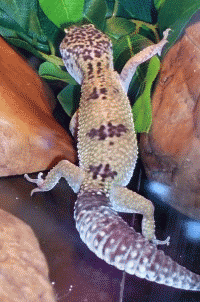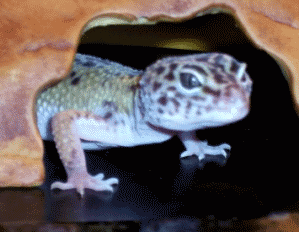Cleaning
I cannot over-stress the importance of regular and thorough cleaning of the vivarium if you are to keep your leopard gecko healthy and minimise the risk of it becoming infected with some nasty parasite.
Poorly shaped, runny or blood-marked stools are a sign that your gecko has contracted an illness. The same is true if you see large pools of liquid or any patches of blood. If this persists over several days, a trip to the vet is strongly recommended. Note that a healthy gecko does not produce liquid urine in any noticeable quantity, so if you start seeing pools of liquid waste you should be concerned.
The vivarium and its entire contents should be given a thorough clean at least once a month, once a fortnight if you can manage it. There are reptile friendly disinfectants (e.g. Beaphar Deep Clean Reptile Disinfectant) which are extremely effective in removing bacteria that can cause such nasties as salmonella, MRSA and E coli. Some disinfectants even claim to kill the cryptosporidium parasite - these may be costlier, but they may help to prolong the life of your lizard.

Whilst cleaning is underway, the gecko must be temporarily housed elsewhere, ideally in a faunarium or similar pet container.
In-between these full-scale clean-outs, you should do spot cleaning every so often, e.g. remove spilt calcium powder, bits of uneaten food or skin shed by the gecko, to reduce the risk of bacterial growth.
Health issues
If due care is given to its diet, hygiene and basic needs, a leopard gecko is a remarkably resilient creature and health issues will seldom, if ever, arise. Most of the illnesses that a gecko is prone to can be avoided by ensuring it has a clean, safe, adequately heated environment and the correct diet. The most common problems are listed below.Shedding problems
A common problem is when the gecko doesn't complete its shedding properly. Bits of skin may still be attached to its extremities or around the eyes. These can be removed by moistening with damp paper towels and (in extreme cases) using tweezers. If skin is attached to its toes, standing the gecko in a shallow (i.e. 1 cm deep) bath of warm water for a few minutes can help to loosen the old skin. This problem can usually be avoided if the gecko has an adequate moist hide.Tail loss
Tail loss can result from man-handling the gecko, most commonly when its owner attempts to pick it up and alarms the lizard into taking fright as he does so. The gecko will survive tail loss but it will take some time (several months) before it grows back, and the replacement will never look as good as the original. The moral: always take extreme care when handling your leopard gecko.Mouth rot
An unsightly swollen mouth is evidence of mouth rot, which is caused by unsanitary housing conditions. This can be avoided by ensuring the vivarium and its contents are regularly and effectively cleaned. It can be treated by swabbing the infected area with hydrogen peroxide. If the swelling remains after a few days, you should take the gecko to the vet.Injuries
Sometimes, a leopard can injure itself whilst climbing about in its enclosure. A common injury is a heat burn caused by contact with a heat lamp - this can be avoided if the lamp is positioned well out of reach of the gecko and/or given a protective cover. If several geckos are housed together, they may sustain injuries by fighting. Serious injuries should be treated by a vet.Respiratory infections
If its enclosure is too cool, the gecko may be prone to a respiratory infection. Symptoms include difficulty breathing and foaming at the mouth. If this happens, it may need to be given antibiotics to recover, so you must consult your vet.Bacterial and parasitic infections
Bacterial infections and parasitic infections - such as coccidia - may arise if the gecko is kept in an unsanitary enclosure and/or given food that is itself unsanitary.
Metabolic bone disease
Metabolic bone disease (MBD) is caused by low calcium levels and can result in swollen joints and fractures to the spine and legs. It can be avoided by ensuing the gecko has a regular intake of vitamin D3, essential for calcium absorption. This can easily be administered by dusting its food with a vitamin-supplemented powder. If left untreated, the gecko will end up with permanent deformities.Dysecdysis
Dysecdysis is caused by poor nutrition and a lack of moisture. This can lead to skin shedding difficulty - patches of old skin are visible and should be removed to avoid infection.© James Travers 2014
 What is causing the obesity epidemic?
What is causing the obesity epidemic?